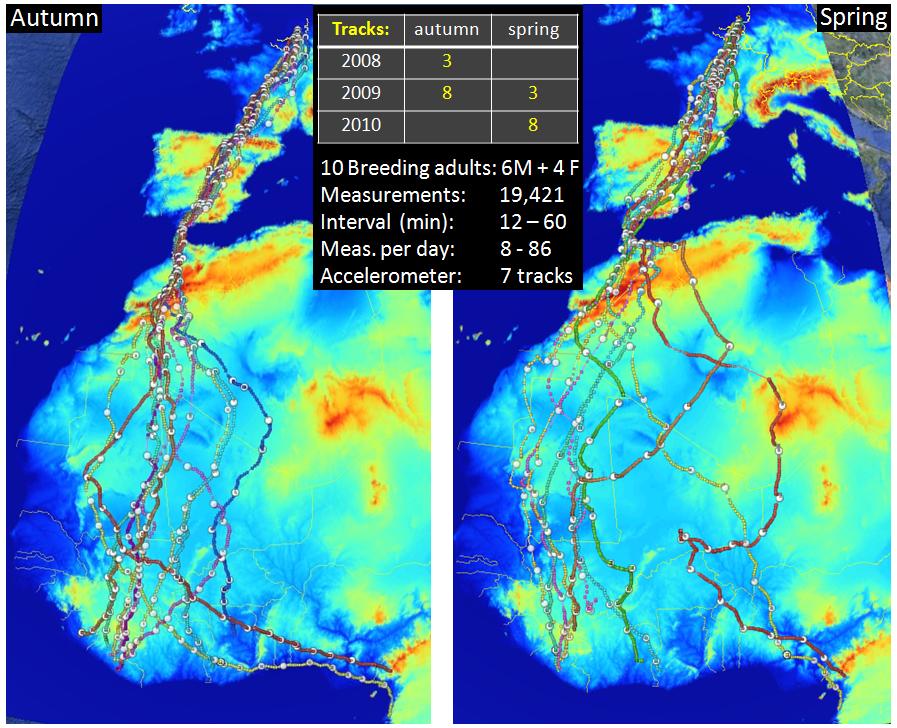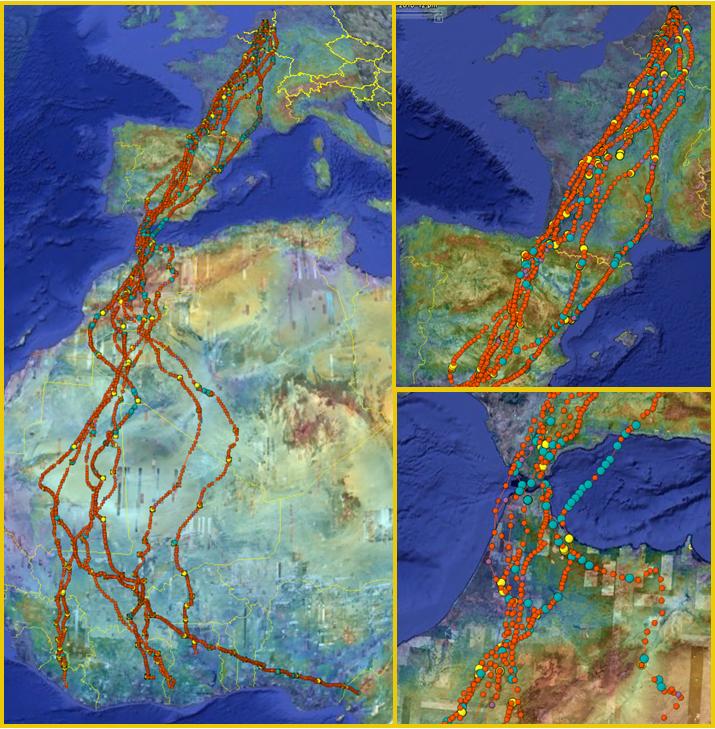
The functionality of UvA-BiTS enables us to register high-resolution migration tracks of Honey Buzzards as they soar between breeding and wintering grounds (fig 1) and answer specific questions at different spatio-temporal scales. By using the accelerometer in conjunction with the GPS we can determine the flight strategy (soaring or flapping) at each location.
Migration data have been collected for all 14 individuals, from the Veluwe (NL) project, that were tagged from 2008 till 2011 (fig. 1). Here we present some of the results obtained from 2008 till 2010 that illustrate the potential for investigating multi-scale effects on the individual decision-rules of migrating Honey Buzzards.
Adult Honey Buzzards are highly adapted – but also restricted – to the use of soaring flight during migration. Indeed, individuals were soaring during no less than 92% of their migration and confirmed the convergence of western European birds at the strait of Gibraltar for crossing the Mediterranean (fig 2, video).
Because rates of atmospheric lift must be sufficiently high to sustain soaring flight, the occurrence of meteorological and geomorphological conditions that cause vertical updrafts are expected to have a great impact on the efficiency of migration.
Because the appropriate timing of migration (departure and arrivals) is a crucial component for the successful completion of the migration as well as other stages in the annual cycle (e.g. breeding) Honey Buzzards must react appropriately to changes in weather conditions (vertical updraft potential, rain events, …) if they are to reach their destination ‘on time’ without depleting their energy reserves.

The video (see below) shows the great extent to which routes of individual Honey Buzzards are determined by the atmospheric conditions encountered en route as a given weather system determines the highly consistent shape between routes of birds traversing a given landscape simultaneously. Whilst it is clear the principal routes of migration along geographical bottlenecks ensure optimal use of atmospheric updrafts other factors such as wind and dust storms may cause significant detours.
Sometimes the cost of dealing with such conditions may be so great that birds may stop and wait for more suitable conditions. It is not surprising that the Veluwe Honey Buzzards only stopped when conditions were very bad, then often waiting for improving conditions for several days. Furthermore, flapping was seldom used, and only occurred for longer distances when birds crossed barriers such as e.g. the Mediterranean (fig 2).
For a bird that relies so heavily on specific atmospheric conditions to complete its migration it is very likely that climatic changes may significantly alter the frequency, geography or timing with which suitable conditions are available, or indeed with which unsuitable or dangerous conditions for a soaring bird prevail (e.g. dust storms, seasonal patterns in prevailing winds). The research with UvA-BiTS on Honey Buzzards will greatly further our understanding of such dynamics.
Contact persons, funders and participants
Willem Bouten, University of Amsterdam Institute for Biodiversity and Ecosystem Dynamics / Instituut voor Biodiversiteit en Ecosysteem Dynamica (IBED) w.bouten@uva.nl
Wouter Vansteelant, IBED-UvA, vansteelant.wouter@gmail.com
Jan van Diermen, Stichting Boomtop, diermenjan@gmail.com
Willem van Manen, Stichting Boomtop,willemvanmanen@boomtop.org
